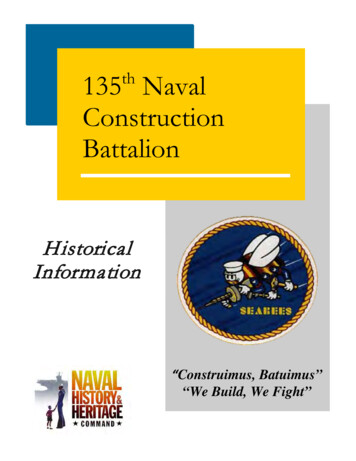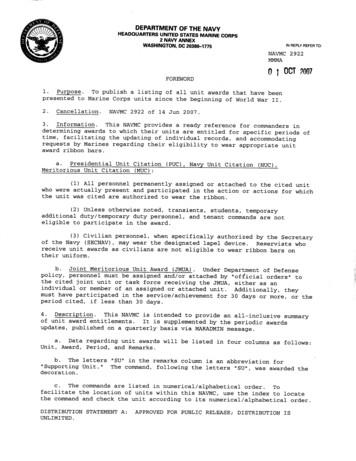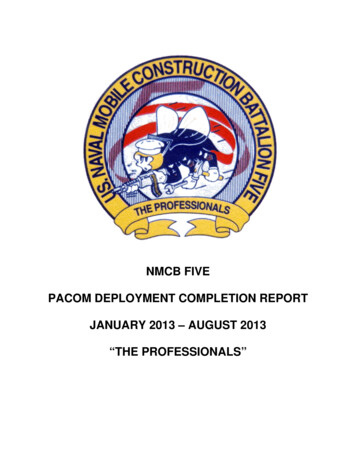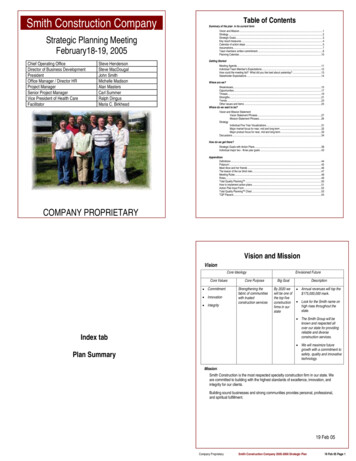
Transcription
th135 Construimus, Batuimus”“We Build, We Fight”
l1l O-Zl-dd -u- ctt re ortth1-4 -1ae1-1-451-1U-4E -7-45 -15-45 -3-16-46 -3-31-45 -4-24-45 4--.d5-4S -l ttcr rn Cctlol!A !' .".,. n ort endorsed bytr P? 0-1' l!"c; h. "11 3 e j, l n con.iqtin l')c "d. 'JP l.c;·2 tt 1 Dee'44 report of 135th CB - no iJifo on location. Report endor ed b1' 30t}-. it g.1 Dec l 44 report of the 30th R e. - A d -ft of 60 men reported to t el th18 Oct 14:4.1 J . roport of the 1 5th C3 - loe ton not stated. Reno 30th rtegiment.1 00 1 45 r port of thp l th CB - loco t on not i en. ? or e .'hComhdArea no 1.nate.l1'1th and 135th CBa tor mount1Jlg eat1aated U May;tor cunUng e.tlmeted 26 June. Pending Clncpoa approval, the3 C:Banleafro pre.ent duties 3- weeka prior to ount t.ug date tor rehrur1l1 t t 10and reouttitting. (Oomtwdaree. Sec Dlsp 130943 Mar'45 to Clncpoa &. CO 8n'D8C)1 Mar l 45 re'DOrt of the 135th CB - located at Tinian. Report end. by th ite.".1 Apr ' 46 rePort of 135th CB - 10 ted at 1n1an. indo by 30t Reg6th .Brig.1 Apr l 45 report of the 30th Re;;. - The 135th CB came ashore on Tin1an on24 Oct'44. :Batt has been lerted and is relieved of pll duties on 6 Jun' 5
l'2'Sthl -therC. .CB list d p.ec.' 01581 dtd 11 Anr' 5 to Co5 -The 135th OB 1 10c tedof 15 pr'45)5 - 1. ,I 5 repo t of tmodifi d by dir et1vcdbeton 3 Jun 145.changed to 34 Jun'1 '45 report of th 135th CB - located at T nian. Bept end. b1ne 135th CB detached from p nt duty.Pro d inccord ttland report to OOll1rt.r Const Tr:oop.l.ariannp )Ai331.(CQ:Ilcervp 0reC di om6-,27--0-1 Jun'45 report of the 30th Reg - The 135th CB hae 31 offiere & 1067on bofor the month of 145. The 135th CB aecured all work on the fiel on 20 May" preparing for forward t:1OTement. 1 Jun l 45 report of the 1 7 5th CB - loe tJun.ao EI . Report Vie. 30th He and 6th Br-.- 1 Jul l 45 - ott o th.Oth RJj,eon 2? Junf'l.of 1 Jul'8- 1-45 -1 Jul l4 5 reuort of thefont ,.a. moT em ut.8-21-45 - 1 Aug'45 report of tne 135th vB - ArrivedRp end 8th ::9rig.s.Orerilf1 1 t- l35th. en replJrte to the 11 tll ;:3ri,g on . : July 1 .5. Orthe 17tfl)r duty. (8th Brig co f nd td 2 ,135t "').oc d8-lUn -58-23-45 1- .o1 5th c lnawa135.h C reforl?th:i on.2 Jul-' lotS. (17tht' l Oinv. 1:t5th ",3).ot the 17th Beg - The 135th Cl3 reportedrted to th14'" er )An& 145 repor tf!e.')n: r.to the 17thlV.tgfor d on 29 Jul 146.f. - l.3e .5 port o ' 1:"' th-;: - . Of!'.' :C n orv· r.10-31-45 For consolidation purposes reouest inactivation when direoted by CNOB, Okinawa the 135th CB. (Oomdr . NOB. Okinawa conf isp 291147 Oct'45 to COll1servpac).12-4-45 Oomservpac reqs NOB. Okina p to inpctiv te 1 5t CE. (Comse c ud)t r 58 td 13 Noy'45 to ONOE. Okine p).12-6-45 - 1 Noy l 45 report of 1 th OB - 10 ted t Ok n . RP12-1: 5 Officers & men under th cornmAn" of 17th a F. e rp.Possi ,ned to ?Bre. conf Itr 9 r O l dtd GO ovl4 to 9th, 86th. 1 5&C1-4l:Rth CB r ort d inacti t d sjnce O D c'45. (CoJ146 to 3uPerQ).1-b.-46 1 5th CB reportf d to 37th Reg . on 21 Uov 1 45. (OinO. :"'7th Re - . GUo). end.to 9th, 86th & 1 5th . CB9 & O MU 21).1-14-46 135th CB we. in otlv.ted on 3 D 0 145. (OinO, 8th Brie. Itr 09 dtdt OinO, 135th OB'. .1- 0 46 1 Oc '45 r :port o.&' 175th CB - 1 ' !. "'n not ati.
BQAlU) 0t·U1.iJun'1 Aug'.·1'441 Oct'1 Dec'1 J8O'45b t 4511 Mar ' 45105110623030'11 Z3?1065107810 53 21 Jul'451 Aug t 451311 Oct l 451 Uov l 45321 591053106'710181019988520!i411 r'451 Jun'45135th Construction Battalion292831.)
CAMP PEARYIn September 1943, some 1100 men, ranging from lads just starting to shave to greyhaired menwho had volunteered to serve their country a second time, men from almost every state, were con verging on C3JJlPPeary in Virginia. Farewells had been said; Good-bye parties were over; Next, aSeabee "boot camp. " As the gates of Peary closed behind them, few fully realized the ominous mean ing of the act. And it is well that such was so. A long train ride, hurrying, lines, wonder, strangeness,lonesomeness, made a two-decker bunk a welcome sight that night.The next morning at 0400, the bugle announced a day that will remain a vivid memory to everyman regardless of the age he attains. From one shed-like building to another went the initiate, shoutedat, hurried, questioned, ordered to undress and put his civilian clotheS in a box in 60 seconds. Nowin his birthday clothes, a big number was painted on his chest and he was no longer "John Smith,"but that number. The barber asked from what state he came. He was just finishing his answer whenthe last of hi hair fell to the floor and his new friends and futures mates'roared with laughter. Th the, took his picture and put it on an 1. D. card so that be could never forget how he looked at thatmoment. Innumerable physical exams, insurance and experience interviews followed .Next, the journey through the clothing issue department began where blankets, mattress, sewingkits, steel helmet, towels, etc. were rained down on the already sagging boot. Pants, shoes, blues,whites, jumpers had to be tried on. The sun was setting as this now-befuddled, exhausted future Sea bee, reeling and staggering under a mattress cover, now holding some 100 pieces of clothing andequipment, made bis way to the big semi-trucks. In a manner destined to remain a mystery, he man aged to get himself and his gear aboard the truck which hauled him to his boot camp barracks- abarren, shed-like structure, capable of housing 60 men.Then, for four long weeks, from 0430 to 2100, itwas: fall in, fall out- Hair lip, 1-2-3-4 lectures obstacle courses- K.P.- shots- geoeral orders-rolling clothes- calesthenics-fue watch- hikes military training- muster- guard duty- waiting for the first mail- washing clothes with a scrubbrush raduty for slight infractions-living in close quarters with new, different men-dose orderdrill- gas chamber-manual of arms- inspection that lasted two hours-rain and mud, yet stay neatand clean-scrubbing barracks and "all else in sight"- inter-regional arguments- training films military courtesy-Scuttlebutt-work details-fading waistlines, sore musdes-dog tags and 1. D.card which presaged the end of "boot." This, and much more was crarruned into the recent civilianuntil he felt as if be bad been in a tailspin, a period that might be summarized briefly as follows:If you do this, that will happen to you ; If you don't do that, this w·U happen to you."Stow gear preparatory for moving in the morning." The order had finally come. On 20 October,the enlisted personnel which were to become the 13Stb Naval Construction Battalion, moved to thegiant B-2 d.rill ball where awaited the officers of this battalion; men who had just been put throughthe rigors of officer training.On this day, a seasoned "salt," viewing these 1100 men, likely would have commented, "They'regreen, raw, unpolished, but they seem to have the makings of a battalion which will write a proudrecord for the Seabees and the N avy."from0,\ \3S"t" nCI
CAMENDICOTTOn the afternoon of 23 October 1943, a band was playing martial music as the 135th NavalConstruction Battalion entrained for its journey to Camp Endicott on the shores of Narra ansett Bayin Rhode Island. Here, the 13Sth graduatets were toe advanced training which emphasizedcombat techniques. In one month, this Seabee battalion was to be trained to operate efficiently under 'any of the many unpredictable conditions.-'Now clad. in green Marine wool pants, shirts and mackinaws, 13,th men began attending a widevariety of schools. Some were given extensive training in machine gun, anti-aircraft and automaticweapons; others, in extended order, judo, barge operation and bayonet and hand-to-hand combattecbni9ues; some attended classes in mosquito control, sanitation, laundry, refrigeration, quonset hutconstruction and general camp maintenance practices. A Seabee battalion had to be self-sufficient Allm::n attended the dry fi re school for training in the use of the carbine and sent a week at the Sun'Valley rifle range wh re they live in quonset uts or the rst time. After a few days of practice firingunder Marine instructors, the 135th shot a battalion score surpassed by few if any.In spite of the busy schedule, life became a little sweeter. Liberty (those few hours the Navyallowed you to catch a fleeting glimpse and remembrance of what civilian life was like) was grantedafter six weeks of strict confinement. Five o'clock liberty lines two blocks long and crowded bussesmeant nothing to the 135th mate struggling to reach Providence, Boston or even New York, wherehe could relax and be himself provided he did not run afoul the shore patrol. LibertY hours passedunbelievably fast; it usually was a rush to get the chit back in the liberty box by 0630. Some failed tomake it; others lost wallets containing lD, cards; the OinC had a Dew duty-captain's mast.After 1700 at Endicott, it was undress blues wben you took in the movies, sipped some beer,went shopping, bowled, or attended a War Bond dance. Yes, life was a little more worth living now.In late November, a lovely New England Indian Summer gave way to old man Winter with hissharp bite. In zero weather, short chow lines seemed and were long; hitting the deck on frozen groundwas not fun; holding a piece with f rost-Dumbed fingers did not help matters."Embarkation leave for men who live East of Mountain Standard Time." Instantly, it was timetables, connections, hours to, wires for money, and no mate was late for his train appointment. Whilethe geographically eligible mates ate T hanksgiving dinner with their families and enjoyed their brieffreedom, other 135th men continued the regular routine and ate their first famous Navy Thanksgiviogdinner.Men back from leaves; new men to fill the battalion's complement ; advanced training completed;the 13'th was ready for its colors. In only 75 days, from a heterogeneous group of 1100 men, the 135thNaval Construction Battalion had been trained, fused and forged into a self-reliant and competentunit.On 7 December 1943, at a formal review on the parade grounds at Camp Endicott, the battalionwas presented its colors and comm issioned. It was p repared to fulfill its assignment in the struggleagainst the Ax is.
CAMP HOLLYDAYOn 18 December 1943 the 13Sth entrained a second time. In three se arate sections which trav elled over three different routes, the battalion left wintry Camp Endicott and four days later, after a2 OOO-inile1.Soon after arrival, Westerners headed for home on embarkation leaves. For those whose free dom bad been spent and who were passing Christmas in camp, it was a long, lonesome day.Navy rules and regulations prescribe dearly bow a battalion should function, Knowledge is onething; to put it into practice is another. Actual operations were necessary. During the four months atGulf ort the 135th handled .obs and duties of alles and sizes. Each man and each de artment hadthe opportunity to learn, understand and iron out the kinks in himself or his epartment.jThe largest of several sizeable construction jobs undertaken and compieted was the Hom Islandrailroad and dock for which work the battalion received a fine commendation from Army officers.Hom Island was a secret Army experimental base. Smaller jobs were barge dismantling at West Pier,paper and tin can conservation, laying out of simulated mine fields for Army War Dog training, c n·struction of camp structures, while mechanics worked at their trade in Navy shops. Shore patrol. firewatch, messenger, boilerwatch, fence guard were only a "few of the many duties.Camp Hollyday was a pleasant place with its southern pines, warm climate, comfortable bar racks with inside plumbing, movies, smokers, stores, attractive messhalls, athletic field, quonset huts,and proximity to fun.Once outside the gate, a mate was almost certain to have a good time in Gulport, Biloxi, Pasca goula or Mobile. And, only two hours away was the great liberty magnet, quaint New Orleans withits world famous French Quarter, good food and abundant entertainment. Here, many a 135th libertyhour and dollar went the way of all flesh.Sports came in for some attention. In a station field meet, the 135th took second place and boththe softball and hardball teams left the base undefeated. The 135th military and swing bands werebusy playing for dances and reviews. "Scuttlebuzz," the official battalion newspaper, made its appear ance.A Base order decreed that effective Easter Sunday, whites were to replace bl ues for dress uniform .Rain, red mud and whites called for lots more elbow grease on the scrub brush and bigger washings.At this time, the Navy undertook considerable reorganizing of C. B. units. Some outfits werebroken up into drafts and C.B.M. u.'s; some men transferred to general service; new men cam::! intothe battalion; units departed; the 135-th was next- maybe; scuttlebutt was always plentiful every where. The 135tb mates were getting impatient; they wanted to move on.Four months of haodling varied and multiple tasks; mistakes made, corrected, and lessons learned;"boots" of six months ago taking on a more seasoned and polished appearance; the 135th was not per fect, but it was functioning reliably and efficiently. The tempo of the war in the Paciiic was increasing."Pack your ditty bags." On 20 A ril 1944, the 135th led bv a band marched intulfdoubts this time-it was West into the shadow 0 the gangplank. But, that is what all had been wait ing and asking for, 50, "Give the highball, cond uctor." And he did.
CAMP ROUSSEAUThrough the swamps of the delta country, across the endless expanses of the great Southwest,over the Rockies, into the picturesque San Fernan40 Valley with its colorful orange groves, vineyardsand palms, then a bit north, raced the troop trains. Mates began to realize just how large their countrywas, of how many smaller and different worlds it was composed.At Cam Rousseau situated on the shores of the Pacific with the mountains in the Eastern back gound, home was a quonset hut, and the bed a cot.Little time passed before men were in lines being issued their own carbines, Browningautomatics, or Thompson sub-machine guns, clips, cartridge belts, ammunition, first aid pouches. Then shelterhalves, a poncho, gas mask, mosquito netting, haversack, canteen, mess kit and foul weather gear.Classes in fixin a ful a Ii ht, and a combat ad: followed. A am to the rifle ran e to 51 ht inthe weapons. Lectures on gas defense and other military su jects were attended. The trip through thegas chamber was too realistic to be funny. A midnight maneuver, which got every man out of bed tobe rushed to the defense of the dock against a fictional attacking enemy, completed the crowded 'three-week equipping and military program.During Leisure hours, mates enjoyed shopping in the big ship's stores, having pictures taken atthe photo shop, drinking beet in the evening in the camp's cosmopolitan business district. Big leaguebaseball, big time shows and movies filled out the entertainment menu.But, the c p entertainment offerings simply could not compete with the glittering liberty para dise which surrounded the camp. Only an hour or so away was Hollywood with its famous canteen,Hollywood and Vine, movie stars and studios; Los Angeles with its Olivera Street, Chinatown, andabout any relaxation a man !Jlight seek; Ventura and Oxnard had their atractiollS, too. This was toogood to last. Correct.Scuttlebutt about the shipping date had crystalized into fact. The date was near. The area becamea scene of hustle and excitement; packing supplies and equipment for overseas shipment; getting per sonal gear in order; good-bye wires and phone calls tG the folks at home; last minute purchases ofeveryday needs. The Last days passed swiftly.On 17 M a 1944, as the sun's re-dawn rays silhouetted the mountains, the 13S th artook of itslast chow in the U.S.A., t, at least, or a ong, ong ttme.ortly, men were in platoon foonationwith all their gear and baggage. One man viewing his mates perspiring and plodding along with 80pound packs on their backs, carbines or other weapons slung over one shoulder, seabags containinga mattress, blankets, pillow on the other, fully equipped belts around them, a gas mask hanging attheir left, ditty bags in hand, summed up the picture in a few words when he said, "By God, this istotal war."Up the gangplank, down a. narrow batch into the hold where bunks were selected, went the II 00.Lunch was served- an apple and cookies. Majestically, the S. S. Meteor sailed out of the harbor intothe boundless blue Pacific.The Pacific was putting out the setting sun, tw ilight changed to darkness, 13Sth men stood quietlyby the rail to catch the Last glimpse of their native land, the land they loved enough that they werewilling to go to far places to play their part in the defense of it.That night, in a shi p's bunk, thoughts were of horne, of the unknown future lying ahead.
AWAIIThe "Meteor's" prow cut a calm Pacific. But, even a calm sea has a roll. This roll caused many a135th mate to spend much time hanging over the rail. These rail-birds with the greenish-yellow pallorbegan to believe nature was reversing herself- namely, all that goes down must come up. However,all survived.For six cia ys it was general quarters at sunri se and 'Sunset, lugging Mae Wests around, watchingfIying fish in the day, and the brilliant phosphorus in the sea at night, sl)' and water, water and s . In the earl dawn of 23 Ma a smaIL s eck a eared on the horizon and soon Diamond Head "Wasclearly visible. Ahead was Hawaii, "the cross roads of the Pacific," the land of the Hula, poi, and lei,where rain falls while the sun shines brightly, where palms and sugar cane sway in the gentle oceanbreezes, where American military might assembled and moved forward against Japan.As the "Meteor" slowly eased its way through bustling Pearl Harbor, men jammed the rails toview an almost unbelievable array of American naval strength. Wherever one looked there werecountless naval craft of all descriptions. Some ships, headed for battle, were new in appeararlce.Others had seen action and carried battle scars.Amid the noise and commotion of this busy harboe:, the 135th disembarked and was taken to anincomplete area on Moanalua Ridge where mountains rise to the east and Hickam Air Field and PearlHarbor Lie to the southwest and west.The battalion quickly completed the barracks and the area. Promptly, men of the 135th were help ing to build facilities and handling other assignments vital to this gigantic base which served as thespringboard of the U. S. Pacific offensive. This offensive was gaining momentum rapidly in August,1944. An assigrunent in a far forward area was imminent; additional realistic military training wasessential. The marches to Red Hill, the climbing of it, sitting in fox holes and crawling on one's bellyon top of it were realistic enough. The eight mile trudge up the mountain to the bivouac made theeight miles back a long, long trail that day. The sham battle on the mountain top 10 a pineapple fieldwas another full day. On military training days, the sun had. a habit of boiling down, humidity wasalways high, and "water discipline" was strictly enforced.Liberty broke the work-training schedule. On Oahu were many scenic wonders and places ofinterest. Honolulu, with its many races of people and its mixtu re of native and modern lile, was nearby.On Sundays, groups piled into trucks with beer and sandwiches and went over Pall Pass, where it isalways raining, to the beaches for a picnic and swim. Many learned that Kanaki juice was a poor sub stitute for the real product.In S ptember the flag pole went up. The battalion was ordered to an undisclosed forward area.On:2 Se tember the first echelon went u the an lank of the APA U.S.S. Adair and ten da slater the second echelon went aboard the Dutch liner, Tj.isadane. After layovers in the Ma[§ba!ls bgthships headed west for Jsland "X ".Batting practice was over ; the deciding game of the world series between the United States andJapan was about to begin. The l35 th was ready to take its place in the lineup and it was well it wasconditioned and prepared.
NIANTInian is one of the Ma.ria.na.s Islands lying near the southern extremity of the Archipelago.Primarily devoted to the raising of sugar cane, the uland has no industrial importance, but it is animportant link in the easterly of the two island roadways from Japan to the Mandates to the south.Tinian is two and three-quarters miles southwest of Salpan, is ten and one-half nautical miles longand has a maximum width of five miles. It covers approximately forty-eight square miles and hasthirty-four miles of shore line consisting of steep rocky c.Iiffs covered with dense vegetation.The civilian population of TInian .ran dose to fifteen thousand before the assault. Of these, th,rgreat majority were Japanese with the balance being made up of Koreans. The Chamorro nativ ·had been removed by the Japanese some time previous. The Japanese were mainly Okinawahs, broughtin by the Nanyo Kohatsu Kabushiki Kaisha or South Seas Development Company of Japan. Ruins ofthe prehistoric Taga race still remain near Tinian Town in the form of monoliths. These were dis covered by Spanish explorers in 1565, but little history of the race is known.The Second and Fourth Marine Divisions began the assault and invasion of Tinian on the morn ing of July 24, 1944. Lieutenant General Holland M. Smith, U.S.M.C., was in command of the Land ing and Amphibious Forces. The tactical surprise was great and with the aid of Seabee; and theirheavy equipment, the beachhead was expanded with rapidity. Twenty-four hours after the Sea beesreached the Jap North Airfield, it was being used by American supply and evacuation planes. TheStars and Stripes were raised over Tinian on August 2, 1944, after five thousand Japs had been killedand principal organized resistance had been broken up.The first echelon of the 135th Seabees landed on Tinian from Higgins landing boats on the earlymorning of October 24, 1944. A temporary bivouac was set up at "96th Street and Broadway" andduring the first few days a permanent campsite was laid out and supplies and equipment were broughtashore. For the first week, K-ratioIl9, supplemented only by hot coffee was the only food available.During the second week, the second echelon landed and C-rations became the regular diet: for monthsto come.construction, while bat talion shops were constructed, organized and put into operation. The first 0 over twenty· Japaneseair raids was experienced during the second week, truck drivers were sniped at during night runs, andseveral Japs were killed by 135th perimeter guards, .but these harassments failed to interfere withnormal operations.D uring the months to follow, the 135th participated in the construction of every N avy and Armyairfield and facility on Tinian. Despite enemy bombing and strafing attacks, a 6,000 foot runway withcomplete facilities for Navy search and bombing planes was completed within the deadline. This jobincluded the greatest earthmoving feat ever attempted by the Navy. On December 20, 1944, the first8,500 foot B-29 field was commissioned and the .first giant superfortress landed on it the next day.This was only the beginning and construction of a similar nature continued until, with the 135th asthe "lead construction battalion," the final super-bomber strip was completed to establish Tmian asone of the greatest military airdromes in the world.The 135th suffered the loss of three enlisted men on Tinian. Two died as the result of enemyaction and one met accidental death from nre arms. In its opiy tactical contact with the enemy on theisland, the battalion was responsible for the killing of twenty-six and the capturing of ten Japanese.
A Miracle of ConstructionA news commentator who visited Tinian shortly after the first Superfortress landed on the islandtold the American public that he had witnessed "miracles of construction"- the accomplishments ofNavy Seabees in the development of Tinian Island as an operational base for planes of the 20th AirForce. The 135th Naval Construction Battalion is proud to have helped made these "miracles"possible.The stocy of the development of a B-29 airfield on Tinian is an interesting one. The north eod ofthe island, fairly level, was the site of one 4,000 foot Japanese runway with facilities for mediumbombers. American forces immediately put this field to use for evacuation and supply planes. TheSeabees also made it possible for the Navy to establish there an operating base for Liberator searchand bombing squadrons within a month. However, because of the proximity of Tinian to the Japanesehomeland, plans were immediately fonnulated for the construction of a base for B-29 super bombers.Japanese propagandists said that it could not be done, but on December 21, 1944, but 36 days afterwork on the first strip had begun, Navy Seabees had finished an 8,500 foot runway for the first Super fortress to land upon. Seven hundred thousand cubic yards of earth had been moved, nine hundredthousand truck miles had been piled up. But this was only the beginning.To begin with, with the exception of the inferior Jap strip, the area was covered with fields ofsugar cane, Jap farm houses, enemy oil and ammunition dumps, revetments and dugouts. The first task,after the preliminary survey was completed, was the cutting of the cane and the stripping of topsoilfrom the solid coral formation of the island. This job took every available shovel, bulldozer, pan,carry-all and truck. Then, the area had to be leveled off before the sub-grade for the airfield could bestarted. Pans, 'dozers and rooters were unable to do the work without the liberal aid of dynamite,and again and again, the island shook. High points were excavated- low spots were filled. Hundredsof men and hundreds of pieces of equipment worked around the clock. The north end of the islandlooked like a huge jig-saw puzzle.Huge coral pits were developed, with hundreds of trucks ruooing day and night from the sourceof the material where they were filled by power shovels, to the airfield area where dumpmen regulatedthe disposal of the loads to prevent the slightest confusion. It was like a well-oiled machine-and with,the tempo increasing, one by one, problems were overcome and difficulties remedied. The coral wasspread, leveled, impacted, rolled- layer by layer- until the final surface had been reached. It was dis covered that the action of the salt water, sprayed from tank trucks on the coral as it was spread androlled encouraged a cementing process. It was also discovered that the pulverizing of the coral bysheepsfoot rollers increased the cement-like formation and speeded the action. All along the line,innovations were introduced as the men observed the results of their work. By the time the first stripwas completed, and a little later, after it had been used and subjected to the tremendous weight of. -the heavy bombers, further improvements in the delicate process were developed and put to use in.subsequent construction.As soon as each phase of the first huge strip had been completed, similar work was started on an other. It was mass production. Deadlines were not only being met, they were being beaten and thequality of the workmanship was improving with experience. Military authorities were so impressedwith the original facilities planned for the island when they neared completion that additional oneswere quickly authorized and further development continued without interruption. The jig-saw puzzlestage was no more.Among other things, V-J Day gave evidence that these "miracles of construction" bad served theirpurpose well.
OKINAWAOn Easter Sunday, 1 Apri11945, doughboys swarmed ashOLe on the Ryukyus Island of Okinawa,only 325 miles from Japan. The Jap resistance was at first surprisingly light, but it soon stiffened alongthe Naha-Shuri-Yooaharu line and a bitter struggle which lasted nearly three months cost the lives ofmany American. men and far more Japanese.On Ti.oi.an. the 135th anxiously watched the news of the battle. Word had been received that thebattalion was to move forward, and forward could mean OOly Qkinawa The departure date was origi nally set for 26 May, but delays because of weather conditions at sea, availability of transportation andchanges in orders from the forward area postponed the sailing until 27 June. The five LST's, loadedwith the battalion's personnel, supplies and equipment, steamed to nearby Saipan where they took 00 ·provisions and fuel. The ships lay at anchor in Saipan Harbor for well over a week and during thisperiod recreation parties were taken ashore to enjoy beer and soft drinks at the Fleet Recreation Areaand to tour the island which for months they had seen from across the narrow channel separating itfrom Tinian.Final! 0 8 ul th lar e con 0 assembled the escort vessels took their rotective ositions ando a e t o ' a a w un. ecause ae" t accommodations aboard LST's, a largenum er of men were required to d down and live topside on the open decks. Amid the trucks, jeepsand heavy equipment lashed to the deck, the men spread tarpaulins for shelter and tried to make them selves reasonably comfortable. The 1200-mile trip was noticeably uneventful, at first. It differed great ly from previous battalion voyages. The apprehension that underwater and air attacks were imminentwas not apparent as had been the case for the past several years, and the water was beautifully calm.But upon reaching the destination, the excitement began. Arriving at Okinawa and attempting toenter Buckner Bay at night, two of the LST's ran aground on a reef. A rising wind and rough seas putthese iliips and their personnel in jeopardy throughout the next day. The accident occurred on the ni
tecbni9ues; some attended classes in mosquito control, sanitation, laundry, refrigeration, quonset hut construction and general camp maintenance practices. A Seabee battalion had to be self-sufficient All m::n attended the dry fi re school for train










